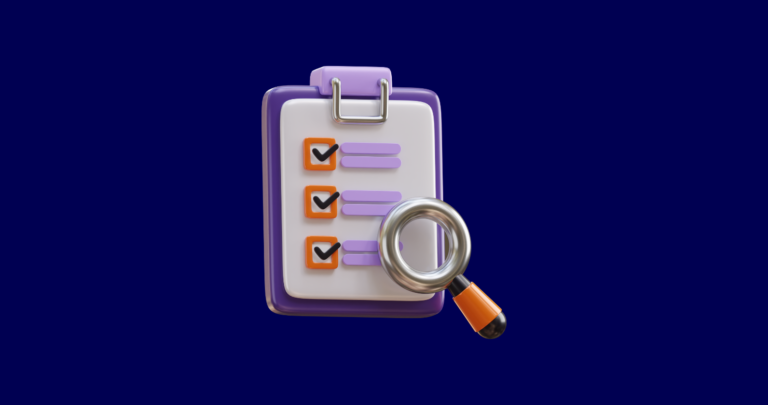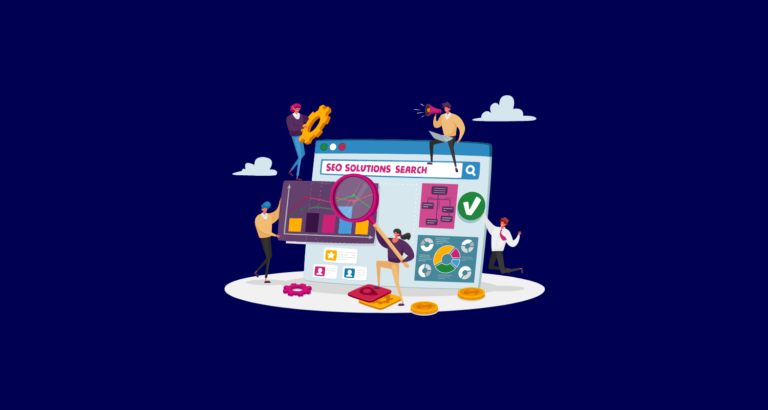On-Page SEO
In the modern world with millions of software products, merely having a great SaaS is not enough. Many people can have a brilliant idea, something unique, but if other potential customers cannot find this business, the growth will cease. This is the area where on-page optimization saves the day.
The B2B SaaS market is quite specific in terms of its difficulties. When dealing with multiple-step buyer funnels, specific audiences, and intense competition, getting to the first Google page is very challenging. Unlike many other industries, SaaS platforms don’t require any type of traffic; they need high-intent traffic, people who are willing to pay.
Here are the best on-page SEO techniques particularly designed for the SaaS industry to enable you to outrank your competition and attract the right traffic to your website.
Why On-Page SEO Matters for SaaS Platforms?
SaaS platforms have their own peculiarities. You are targeting a certain audience, and your site may be for the primary purpose of creating awareness of your company and getting users to come to a specific sign-up page or getting them to try out a demo. So, on-page SEO is extremely important for SaaS. It is about making sure that your platform is visible in front of those perfect customers, increasing your authority, and converting more visitors to customers.
On-Page SEO Benefits for SaaS
- Skyrocket your organic traffic: Just think about being found by a higher number of the right audiences through search engines. This, in turn, can happen when optimizing your content, meta tags & internal linking to a webpage or post. BrightEdge reported that in every industry, 53% of site traffic results from organic search, and thus on-page SEO is critical for SaaS businesses.
- Turn more visitors into customers: On-page SEO is not about getting traffic to your website it is about making sure your content matches their needs so they proceed. Conductor study reveals that it is possible to double your conversion success if your content is optimized.
- Become a trusted authority: SaaS website optimization helps to establish credibility in the eyes of the search engine. Domain authority is one of the Google ranking factors. The page from an authoritative domain will be ranked higher than a page in a domain with low authority.
In the world of B2B SaaS, it’s important to stand out from the competition. On-page SEO provides you with a great way to do it: more visibility and better quality leads.
Semantic SEO Optimization Factors
Semantic SEO is more or less an advanced form of SEO strategy. It is about providing useful and informational material, which contains more than simply key phrases needed to rank high on the search engine result page. In the case of SaaS companies, people are searching for detailed information, and thus focusing on these aspects is essential.
Search Intent Alignment
It is important to try and determine what it is that your intended audience is actually seeking when browsing for content. Are they simply looking for an answer to a few questions, evaluating one company’s offerings against another’s, or are they looking for some solutions? Your content has to align with the purpose of their visiting your website or using your app.

Contextual Keyword Targeting
Instead of focusing on specific words try to use related words and phrases that are more encompassing of a topic.
Entity-Based Content Optimization
Use real-life topics (like SaaS or Search Engine Optimization tools, or algorithms) in your content. These should be the subtopics of the topic of interest.
Latent Semantic Indexing (LSI) Keywords
LSI keywords (phrases that are similar to your main keyword) play a key role in determining what your content is all about. Using additional phrases, such as meta tags, page speed, structured data, and internal linking next to your primary keyword enriches your content.
According to Backlinko, the pages which include semantically relevant content as well as LSI keywords, perform well in the search engine ranking.
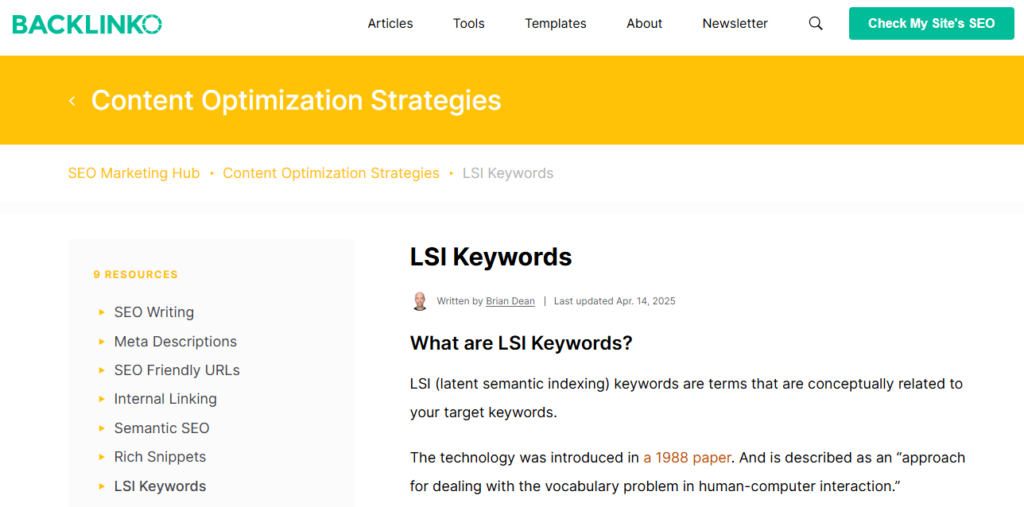
Content Clusters & Internal Linking
Building topical relevance is content clusters, where a primary or ‘pillar’ page anchors sub-pages (or cluster content). For instance, your pillar page for ‘On-Page SEO for SaaS’ can link readers to other articles such as ‘SEO tools for SaaS’ or ‘Technical SEO for SaaS.
Structured Data (Schema Markup)
Using FAQ schema, article schema, etc., guarantees understanding of the content structure by the search engines. This should be done especially by SaaS companies that want to target the rich snippets or any featured results.

Moz research indicates that the use of structured data improves CTR because your content prominently features in search results.
Synonyms & Variants
To reach more people with your topic, try using any of the following keywords for your target topic: SEO strategies, site optimization techniques, SEO for SaaS businesses. This approach is useful for gaining general knowledge of a topic and also for capturing more keyword phrases that will drive traffic from the search engine. Here you can learn about SaaS SEO tools to optimize your website’s performance.
User Experience & Behavioral Metrics
Google is also interested in how its users engage with content that has ever been linked to your website. Better dwell time, lower bounce rates, and quality content are the key things that directly influence SEO results. Backlinko states a 25% rise in rankings for sites with enhanced user engagement indicators.

On-Page SEO Checklist for SaaS Websites
There is a set of issues that need a detailed approach while developing an on-page SEO strategy for your SaaS website. Here’s a practical SaaS SEO checklist to keep you on track:
1. Keyword Research:
- Find the Right Keywords: When it comes to keywords, it is critical to find out what your niche market is talking about. Consider more specific and, in some cases, longer tail keywords that would allow the user to find what they need. Tools include the Google Keyword Planner and Ahrefs among others. Here is the complete guide on SaaS keyword research in 2025.

- Focus on Conversions: Data available at Backlinko reveal that results with long-tail keywords are likely to act better than a broad head term.
2. URL Structure:
- Keep it Simple and Clear: Your URLs should be short and clear. They should contain the relevant keywords that will be useful in the page rank. This is useful to both the search engines as it informs them what your page is all about and for the users.
- Ideal Length: According to Moz, the length of a URL should be between 50 and 60 characters.
3. Title Tags & Meta Descriptions:
- Craft Compelling Descriptions: Your page has to be optimized with the right keywords in your title tags and meta descriptions.
- Stay Within Limits: Both title tags should ideally be less than 60 characters long while meta descriptions should be less than 155 characters long.
- Boost Clicks: Yoast proves that when you optimize meta descriptions, the click-through rate will improve.
4. Image Alt Text:
- Describe Your Images: Ensure you use consistent descriptive alt attributes for your images and incorporate keywords within an alt text. This is useful for search engines to decipher your images and can enhance your ranking in image search.
- Rank Higher: Optimisation of the image alt-tag is one of the factors that can help to increase your chances of having your products featured in the hot product lists.
5. Internal Linking:
- Connect Your Pages: Always create many internal links pointing to the related content on your site to improve the overall ranking. This makes usability easy and also informs Google about the structure of your content.
- Keep Visitors Engaged: Proper internal linking can help increase the average time spent on a site.
6. Mobile-Friendliness:
- Think Mobile-First: Ensure, especially, that your SaaS website is mobile-responsive and that it can function well on mobile platforms. Google has an algorithm that ranks the sites based on their compatibility with mobile devices.
- Go Where Your Audience Is: Statista states that mobile accounts for more than 50% of all web traffic; thus, this is crucial!
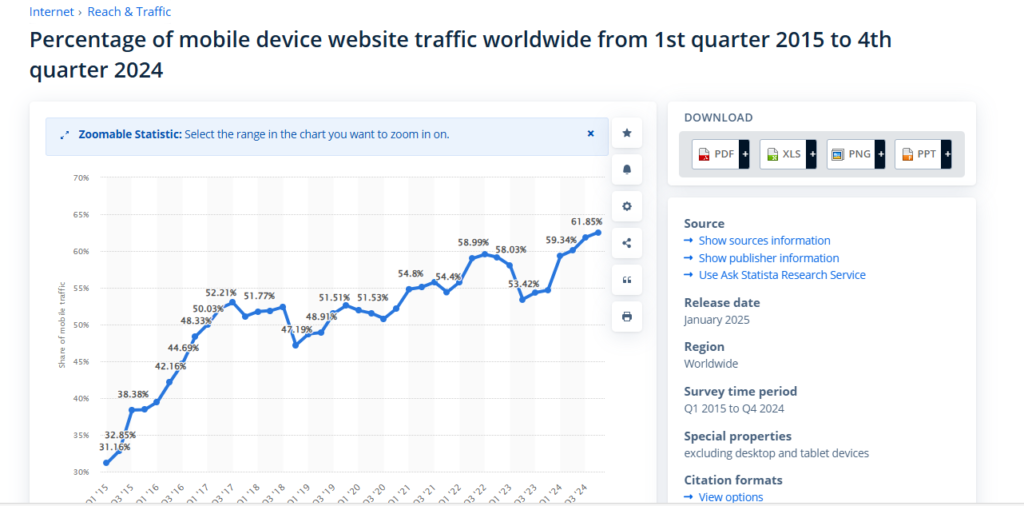
7. Page Load Speed:
- Optimize for Speed: Nobody likes a slow website! Use tools like Google PageSpeed Insights to see what may be dragging your site’s speed.

- Reduce Bounce Rate: Research by Google reveals that page responses that take two seconds or less have a lower bounce rate compared to more slowly loading sites.
By following these guidelines, you can easily approach your SaaS website with concrete goals on how you can win at on-page SEO.
Key On-Page SEO Factors to Consider
Several significant on-page factors can increase and decrease your SaaS website’s visibility on search engines. Let’s break them down:
1. Title Tag Optimization
Ideally, the title tag should be seen as the headline of your particular web page. It informs both the user and the search engine what your page is all about.
- Keep it short and sweet: Aim for under 60 characters.
- Include your target keywords: Ensure that these keywords are closely related to the topics of the page.
- Be enticing: Make a catchy title that will bring traffic to your blog.
An analysis of key findings revealed that improving the title tags can grant an increase of 20% of the overall click-through rates or CTR, so it’s important.
2. Meta Descriptions
Meta descriptions do not have a direct relation to your rankings but are very important for making people follow the link in search results.
- Craft concise, keyword-rich descriptions: Briefly describe the content of your page and encourage people to come to your site.
- According to Kinsta, optimizing meta descriptions could increase organic traffic by 5.8%.
3. Header Tags (H1, H2, H3)
Headers are useful when structuring your content because they make it easier for the reader and the search engines.
- Always incorporate the main keyword you want to target in the content of your page in the H1 tag.
- Your content needs to be divided into sections and it is done with the help of H2 and H3 tags; use secondary keywords if necessary.
4. Content Quality
The quality of the content is the king of on-page optimization.
- Focus on providing value to your audience: Respond to the problems of your clients and provide answers.
- You should post tips & instructions, success stories, product reviews, and detailed posts.
- According to the Content Marketing Institute, organizations that create valuable content acquire three times more leads.
5. Image Optimization
Adding more images to your content makes it more attractive, but the images should also be optimized for SEO.
- Use descriptive file names and alt text: This aids the search engines in completely understanding what your images are about.
- Compress your images: Large images make your page load slowly and this may reach the point of affecting your ranking.
- Google ranking factor reveals that pages with optimized images are tend to rank well in Google.
By focusing on these areas, you can vastly improve your SaaS website’s on-page SEO and draw targeted visitors to it.
Learn in-details about: How to improve SEO for SaaS Companies?
SaaS-Specific On-Page SEO Strategies
Organizations in the SaaS industry consistently experience different SEO issues, and this is even more so when it comes to marketing to a select group of business-savvy clients. Here are some tailored on-page SEO strategies to help you win:
1. Long-Tail Keywords: Your Secret Weapon
Long-tail keywords are as valuable to SaaS firms as gold. These are more like words that are used when people are halfway through the decision-making process.
- It’s better to use such keywords as “best CRM software for small business” instead of simply “CRM software.”
- According to AIOSEO, long-tail keywords make up 70 percent of a number of all Web searches. They convert 2.5 times more often than other, more generalized, keywords.

2. Pillar Pages & Content Clusters: Build Your Authority
Developing the pillar content pages and content clusters lets other people realize that you know what you are talking about.
- A pillar page is a single, comprehensive page about a distinct, wide topic that redirects to additional, related, and more focused articles (for example, “On-Page SEO for SaaS” and “SEO tools for SaaS” or “Technical SEO for SaaS”).
- The simple and clear structure of such websites results in a remarkable growth of organic traffic! It can be very effective in terms of content management and boosting your SEO.
3. Content that Answers Questions
Simply aim to produce the type of content that answers your visitors’ search queries and offers real value.
- Consider articles such as how-to’s, examples, product reviews, and tutorial videos.
- Google prefers quality content that satisfies the user’s query and effort. Something very desirable in the B2B industry where the user is a decision maker and searching for a solution that’s ideal for their company.
4. Avoid Keyword Cannibalization
If you have a lot of content – do not make a number of web pages striving to rank for the same keyword.
- This may mislead the search engines and compromise your ranking.
- Perform a content review to ensure that there are no other similar pages and if they exist, then combine them.
- Solving the issue of keyword cannibalization can help increase the ranking by a noticeable percentage.
5. Aim for Featured Snippets
Also known as position zero, featured snippets are those small boxes that appear at the top of some search results. It’s a good place to gain further visibility as they are.
- Organize data according to questions and answer the questions directly. They could be in the form of FAQs, bullet point forms, or numbered points.
- According to Ahrefs, pages that appear in the featured snippet get a 26 percent increase in the click-through rate.
If implemented correctly, these techniques will help you focus on your SaaS business niches and attract more prospective buyers.
On-Page SEO Website Ranking for SaaS
To get your SaaS website climbing higher in Google’s search results, your on-page SEO needs to focus on two key things:
- Ensuring customers get a positive impression every time they visit your website.
- Making it easy for the search engine to crawl through the content on your site.

An ideal site should accomplish the two objectives of increased traffic and conversion.
Improving User Experience (UX)
One of the most important factors for the ranking of your website by search engines is user experience. Another thing that Google’s algorithm considers important is the “Core Web Vitals”. They track the speed at which your site is being loaded, how interactive it is, and how stable it actually is on the screen.
Keep Visitors Engaged
Two key metrics that affect your rankings are:
- Bounce rate: the number of users who navigate through your website and then bounce right back.
- Dwell time: how long individuals spend on your page.
Page Speed Optimization
Website loading speed is crucial for rankings, primarily because SaaS companies are based on solid user experiences. If there is anything that is holding your site back, then tools such as Google PageSpeed Insights will be able to find it.
Mobile Optimization
Google prefers what it calls ‘mobile-first indexing’ – instead of viewing the desktop version of your site, it considers the mobile version first.
On-Page SEO Types for SaaS
It is important to learn that on-page SEO is not universal. Just like with most other types of businesses, there are several success factors for SaaS that help increase your visibility, the usability of your site, and the satisfaction of the search engines. Let’s break down the different types:
1. Content Optimization: The Cornerstone of SEO
On-page SEO is all about developing excellent content for your website. This is why your content must solve the problem that your audience has. You can do it through informative blogs, comprehensive product reviews, or case studies.
2. Technical SEO: The Behind-the-Scenes Work

Technical SEO is mainly focused on making your website easily understandable and accessible for search engines to crawl and index. It involves optimizing elements like:
- Page speed
- URL structure
- Internal linking
- Schema markup
3. Mobile Optimization: A Must in Today’s World
Unfortunately, most people use mobile devices to access the web, so your site needs to be friendly to mobile users. If your site is not mobile-friendly, then you will stand no chance when it comes to ranking on Google because Google adopted mobile-first indexing.
- According to Think with Google survey, websites that are mobile-friendly are 74% likely to engage visitors. While nonmobile-friendly websites have high bounce rates.
4. User Experience (UX) Improvements: Keep Visitors Happy
This is a very important consideration if you want your site to rank well with certain search engines. when it comes to UX everything that is understandable, clear navigation, good design, readable text, and the possibility to interact with elements can influence rankings.
- A report discovered that companies achieve an ROI of up to 100% when they make improvements to UX. What this all means is that paying more attention to the UX can help you get better business results.
Therefore, by knowing the difference between these various kinds of on-page SEO, you’ll have a set plan to build a much more efficient strategy for your SaaS website to attract more pertinent traffic.
Using an On-Page SEO Checker for SaaS Websites
On-page SEO checkers can be considered as some sort of personal web inspector. They assist you in the process of auditing your SaaS website, to ensure that all necessary aspects are SEO-friendly. These tools regularly check your site for risks and provide important suggestions to increase ratings and improve user satisfaction.
How to Put an On-Page SEO Checker to Work?
Tools like SEMrush, Ahrefs, and Moz also have on-page SEO checkers in their tools list. They analyze a range of elements on your website, like:
- Meta tags
- Keyword usage
- URL structure
- Internal linking
Key Metrics to Watch
When using an on-page SEO checker, keep an eye on these important metrics:
- Keyword Density: Ensure that you’re using both your primary and secondary keywords effectively without overdoing it.
- Readability: Is your content easy to read for people and to crawl and index for search engine bots?
- Internal Linking: Do you have internal links on your site that connect relevant content appropriately?
- Technical SEO Factors: The issues that one should check include schema markup, page, speed, and mobile usability.
Several SEO authorities state that websites that make use of SEO audit tools frequently observe better search rankings in the shortest time. For SaaS platforms to present high competitiveness and receive organic traffic, these tools are a necessity.
Common On-Page SEO Mistakes in SaaS
As much as you’re committed to doing the right thing and creating a quality SaaS platform with a solid SEO strategy, mistakes are common. Let’s explore these pitfalls so you can steer clear:
1. Keyword Stuffing: Less is More
We all want our site to rank as high as possible. Sometimes this means trying to fill your content with as many keywords as you can. But this backfires! Not only does it produce a very poor reading experience but it is also less favoured by search engines.
- Focus on natural language: Don’t overdo your primary and secondary keywords within the content; the main goal is readability and user-friendliness.
- Google’s Search Quality Guidelines show that keyword stuffing is deadly for your rankings. Always keep in mind that you are also optimizing for people not just for the different algorithms out there.
2. Over-Optimization: Don’t Overdo It
However, as with any form of optimization, moderation is key, and keyword stuffing can only work against you.
- Some of the things to avoid are, using too many internal links, adding plugins that unnecessarily, and frequent changing of title tags and meta descriptions.
- Ahrefs recommends maintaining a balance between optimization and overdoing. The main thing that one needs to bear in mind is that too many updates may lead to search engine confusion and thus damage your performance.
3. Poor Content Structure: Organize for Success
Confusing content is a problem for both end-users and search engines.
- Use heading (H1, H2, H3, etc) to divide your content and make it simple to comprehend.
- Always have your content divided into sections and make sure it is well labeled.
- Experts said that there is a highly remarkable increase in organic ranks and search ranking when content is designed effectively and properly.
4. Keyword Cannibalization: Don’t Compete with Yourself
When two or more pages on your SaaS website are optimized for the same keyword, they fight for the same rank.
- This severely impacts your rankings and ensures that none of them can deliver its best performance.
- Conduct an audit to find a similar set of pages to merge and replace.
- It is not good for SEO because it makes two or more of your pages fight for a higher rank. It can decrease the rank of both as well.
5. Duplicate Content: Originality Matters
It is an absolute no-no to have the same content in two or more pages of your website whether it was a mistake or not.
- All of the above results in confusion for the search engines on which version to rank and reduced visibility for each.
- Google Similar pages, Copyscape, or Siteliner are excellent tools to solve such an issue.
- Learning how to delete duplicated pages can help increase your search rankings impressively.
If you avoid all of such mistakes, your SaaS on-page SEO will be relevant and impactful, bringing more leads to your web page.
On-Page SEO Techniques & Tools for SaaS Platforms
In the world of business, especially where SaaS is concerned, basic SEO strategies won’t suffice; one needs superior strategies and tools to rank highly. Here’s a look at some powerful options:
1. TF-IDF Analysis: Understand Your Competition
Another approach to learning about competitors is similar to opening the adversary’s playbook, namely the TF-IDF (Term Frequency-Inverse Document Frequency). It reveals the most often-used keywords on the leading pages in your field.
- By doing so, you establish web pages that are semantically superior and optimized for the given words and phrases.
- Software such as Surfer SEO or SEO PowerSuite also shows TF-IDF analytics which can help in adjusting the content strategy.
2. Image Optimization: Don’t Neglect the Visuals
You should use images in your articles so that they would become more attractive to your readers, but also, the images should be integrated into SEO strategies.
- Concentrate on optimization processes, such as image compression, naming files meaningfully, and adding meta descriptions in images.
- Compressed images are more likely to rank higher, particularly in areas that have a great focus on visuals such as the SaaS industry.
3. Schema Markup: Give Search Engines a Helping Hand
Schema markup (structured data) is a way to give more context to search engines about the content of your website.
- For SaaS companies, this will help you get more chances to show up in rich snippets (search listings that contain extra details).
- You can use FAQ schema, product scheme, or article scheme to increase your visibility.
- As stated by the Search Engine Journal, using schema markup makes your web page qualify for rich snippets in the SERPs.
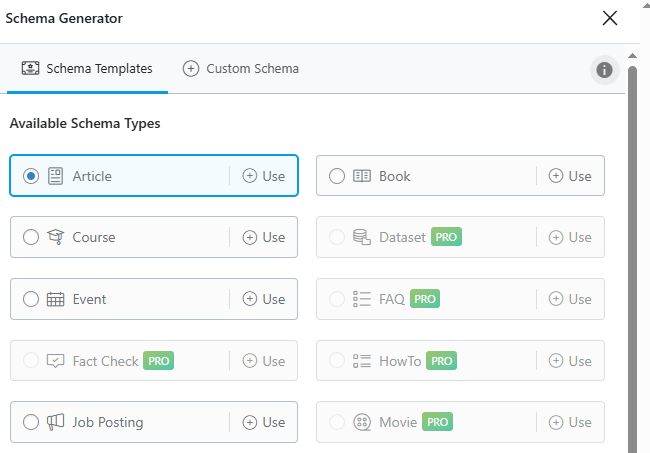
4. SEO Plugins: Simplify Your Workflow
If your SaaS website is developed on WordPress, there are many SEO plugins. Such as Yoast plugin, RankMath SEO plugin, and All in One SEO (AISEO) plugin. They assist you with an on-page optimization process and enable you to edit meta tags, create XML sitemaps, and get a general SEO analysis of your site.
5. Semrush & Ahrefs: Your SEO Powerhouses
Tools like Semrush and Ahrefs have many on-page SEO features to conduct a site audit, identify opportunities and problems, and improve it.

- Analyze keywords, content, various on-site factors, and other technical aspects of top-level SEO.
- Websites that perform routine SEO audits with these tools see an incredible boost in rankings.
If applied wisely, you will be able to make your on-page SEO of the SaaS platform even better and attract more organic visitors.
Final Thoughts
Any SaaS business that wishes to increase its ranking within search engines and attract more organic traffic and sales cannot do without on-page SEO. That makes it the foundation of success for any SaaS business that aims at getting online exposure and increasing conversion rates.
Keyword optimization, technical SEO, UX, and semantic SEO all give organizations an efficient way to position SaaS platforms as authorities in a particular market. It helps them drive high-quality organic traffic, resulting in conversions. From using ordinary SEO plugins like Yoast and Semrush to using sophisticated strategies such as the TF-IDF and schema markup, the journey towards improving SaaS on-page SEO is possible for every firm.
In this way, SaaS businesses level up their game and attain sustainable growth as a result of such directing strategies. The strategies include constant provision of valuable content, the usage of the most effective UX trends, and following all up-to-date trends in search engine optimization.



